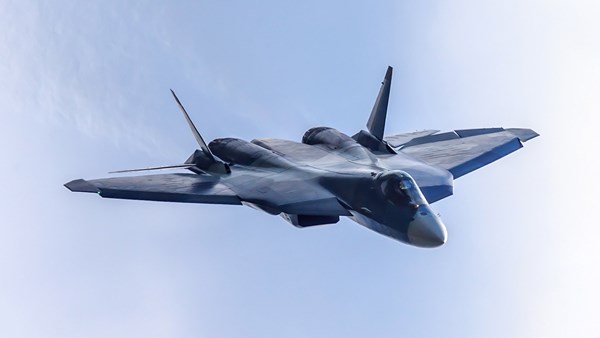Russian press: Su-57’s flaws make it useless
Although Russia’s Su-57 fifth-generation fighters are competitively priced, neither China nor Iran are interested in them, and not even Turkey, which recently expressed admiration of the Su-57, writes the Russian news agency Svobodnaya Pressa (Free Press). According to the columnists, the primary reason for this aversion is the fighter’s large number of shortcomings.
Development of the Su-57 began well over ten years ago, and the fighters have been showcased and tested, and even begun serial production, in a way. The Russian Defense Ministry has already ordered 76 of the fighters, enough for three aviation regiments. One could say that, up against the American F-35 fighter, which until recently was considered the best in the world, the Russian aircraft is starting to become a serious competitor. However, something has gone wrong – the Su-57 has not enjoyed much popularity. At least, no buyers have been found.
At the MAKS Air Show, where the export variant of the Su-57 was presented, it did not draw particular attention. Turkish President Recep Erdogan, who attended the show with Vladimir Putin, did indeed inspect a Su-57. He admired it and said that he was open to buying these fighters instead of the American F-35, but nothing more came of it. Turkey is more interested in buying Russia’s Su-35 light fighters, which have already proved themselves to an extent in Syria. India, too, has avoided buying the Su-57, but expressed great interest in the Su-35, which is classified as belonging to the 4++ generation.
What do other countries find disagreeable about the Su-57, whose price is significantly lower than the American F-35 and even the French Rafale? And why does Russia so badly need to export this plane? Let us start with the latter. The Russian Defense Ministry has ordered 67 such fighters, which will be delivered over at least five years. This is extremely little, even considering that the Su-57 is not considered a full replacement for the Aerospace Forces’ fleet, but rather a coordinator, a tactical strategist, which can lead an entire air group consisting of other fighters, assault fighters, helicopters and even ground divisions. It’s considered a kind of flying brain, which can engage in aerial warfare thanks to its high maneuverability and powerful weapons. However, just under 70 Su-57s in the Aerospace Forces is still very little. As of September 2019, the US has already produced 425 of its F-35s, and production is still continuing.
One could suppose that there is simply not enough money. Putin has given the go ahead for its launch, calling it “the best aircraft in the world”. On the other hand, the cost of the F-35 dropped from $108-112 million to $85 million, which made it more popular among buyers. Putin decided to put a 20% discount on the Su-57, bring its price down from the quoted $46.7 million to $34.7 million. But even these funds are not enough, and so only exporting can help, since it brings in funds for further production. For example, several years ago India bought 200 Su-30MKI fighters from Russia for $12 billion. The funds helped pave the way for the production of the new Su-35s. Similarly, by buying several hundred T-90S tanks, India saved the declining manufacturer UralVagonZavod, which was on its last legs, and could not meet the needs of Russia’s own army.
In general, without sales, there are no weapons. Most funds are being used to develop cruise missiles and hypersonic weapons, which Russia currently considers a priority. There are simply not enough funds for fifth generation fighters. The same applies to the widely advertised T-14 Armata tanks. Upgrading T-90 and T-72 tanks is far cheaper, and that is what buyers are going for. The same fate apparently awaits the new Su-57 fighter, which seems decent, but unlike the AK-47, has not gained popularity.
The Su-57 is both praised and scorned. The fighter will certainly have a future, but in its current form it is limping. The Chinese news agency Sina, in its appraisal of the Su-57 export variety that was presented at the MAKS-2019 Air Show, said that it is “worse than the original”, and that “nobody needs it”. No one has expressed interest in the fighter. “The primary difference is that its ‘filling’ is considered simple with respect to avionics and fire control systems, and the bandwidth of the on-board radar has been reduced. The flight capabilities have been reduced, the interference protection is less effective, the number of trackable targets has been minimized. Buying such an aircraft would be disappointing. The technologies used are more interesting than the Su-57 itself,” observes the Chinese news outlet.
